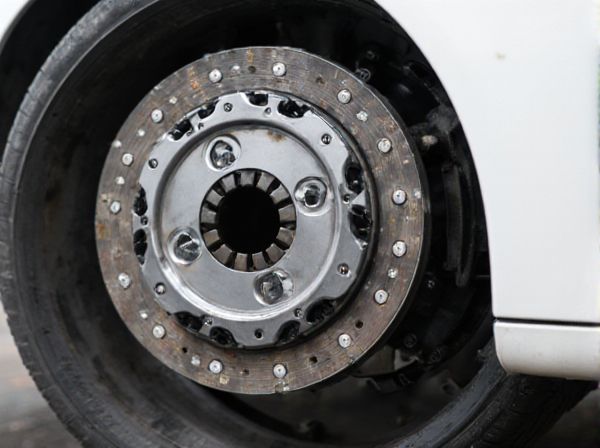
Photo illustration: Manual Clutch vs Automatic Clutch
A manual clutch offers greater control over gear shifts, providing a more engaging and responsive driving experience. Automatic clutches simplify driving by eliminating the need for manual clutch operation, enhancing convenience, especially in heavy traffic. Your choice depends on whether you prioritize driving involvement or ease of use.
Table of Comparison
| Feature | Manual Clutch | Automatic Clutch |
|---|---|---|
| Control | Driver manually operates clutch pedal | System automatically manages clutch engagement |
| Skill Level | Requires driver skill to shift smoothly | Minimal driver skill; easier to use |
| Driving Comfort | Can cause fatigue in heavy traffic | Improves comfort, reduces fatigue |
| Fuel Efficiency | Potentially higher with skilled driving | Generally optimized by software for efficiency |
| Maintenance | Clutch components subject to wear from manual use | May have more complex parts, but less manual wear |
| Cost | Typically lower initial cost | Usually higher due to technology integration |
| Best Suited For | Enthusiast drivers, precise control | Urban driving, convenience-focused users |
Introduction to Manual and Automatic Clutches
Manual clutches require the driver to engage and disengage the clutch pedal to shift gears, providing direct control over power transmission between the engine and the drivetrain. Automatic clutches use sensors and actuators to manage gear transitions without driver intervention, enhancing convenience and reducing the learning curve for new drivers. Understanding the mechanics of both systems highlights differences in user control, driving experience, and maintenance requirements.
How Manual Clutch Systems Work
Manual clutch systems operate by engaging and disengaging the engine from the transmission through the use of a clutch pedal, which controls a friction plate pressed against a flywheel. When the clutch pedal is pressed, the friction between the engine and transmission is released, allowing the driver to change gears smoothly without grinding. This mechanical connection ensures precise control over power transfer, making manual clutches ideal for performance driving and fuel efficiency.
Understanding Automatic Clutch Mechanisms
Automatic clutch mechanisms use sensors and actuators to engage and disengage the clutch without driver input, improving ease of use and smooth gear transitions. These systems often rely on hydraulic or electronic controls for precise modulation, reducing wear and enhancing vehicle efficiency compared to traditional manual clutches. Understanding the integration of automatic clutch technology reveals its role in modern transmissions such as automated manual transmissions (AMT) and dual-clutch systems (DCT).
Key Differences Between Manual and Automatic Clutch
Manual clutches require driver engagement to control gear shifts and torque transfer, relying on a clutch pedal for precise operation, while automatic clutches use sensors and actuators to manage gear changes without driver input. Manual systems offer greater control and fuel efficiency, favored in performance driving, whereas automatic clutches provide convenience and smoother transitions in urban or stop-and-go traffic. Key differences include driver involvement, mechanical complexity, and responsiveness, with manual clutches demanding skill and timing, in contrast to the seamless automation found in automatic clutches.
Performance Comparison: Manual vs Automatic Clutch
Manual clutch systems provide greater driver control over gear shifts, resulting in more precise performance and enhanced fuel efficiency in demanding driving conditions. Automatic clutch mechanisms offer smoother transitions and reduce driver fatigue by automating gear engagement, though they may sacrifice some responsiveness and control compared to manual setups. Performance differences between manual and automatic clutches significantly impact acceleration timing, torque delivery, and overall vehicle handling dynamics.
Driving Experience: Manual Versus Automatic Clutch
Manual clutch systems offer drivers enhanced control over gear selection and engine power, resulting in a more engaging and responsive driving experience. Automatic clutch systems simplify the driving process by eliminating the need for manual pedal operation, providing smoother gear shifts and reducing driver fatigue in traffic conditions. The choice between manual and automatic clutches significantly impacts driver involvement, with manual clutches favored for sportier, performance-oriented driving and automatics preferred for convenience and ease of use.
Maintenance and Longevity of Clutch Types
Manual clutch systems require regular adjustments and periodic replacement of the clutch disc, pressure plate, and release bearing to maintain optimal performance and extend lifespan. Automatic clutches, often integrated with automated manual transmissions or dual-clutch systems, reduce wear through controlled engagement but still need occasional fluid changes and inspection of hydraulic components. Proper maintenance schedules directly influence the durability and reliability of both manual and automatic clutch systems, with manual clutches generally demanding more frequent servicing due to mechanical wear.
Fuel Efficiency: Which Clutch Is Better?
Manual clutch systems typically offer better fuel efficiency due to direct control over gear shifts, allowing drivers to optimize engine power and reduce fuel consumption. Automatic clutches, while more convenient, often rely on electronic controls that may cause slight fuel loss during gear transitions. Studies show manual transmissions can improve fuel economy by up to 10% compared to automatic clutches in comparable driving conditions.
Best Applications for Each Clutch Type
Manual clutches excel in performance vehicles and off-road applications where precise control over gear shifts and engine power is crucial for optimal driving dynamics and traction. Automatic clutches are best suited for urban commuting and stop-and-go traffic, offering ease of use and reducing driver fatigue by eliminating the need for manual gear shifting. Motorcycles, scooters, and small vehicles often prioritize manual clutches for their responsive control, while automatic clutches enhance convenience in heavier vehicles and beginner drivers focused on comfort.
Conclusion: Choosing Between Manual and Automatic Clutch
Choosing between manual and automatic clutch systems depends on driving preferences and vehicle usage. Manual clutches offer greater control and engagement, ideal for performance enthusiasts and those seeking fuel efficiency, while automatic clutches provide convenience and ease of use, especially in urban traffic conditions. Evaluating factors such as driving style, maintenance, and comfort will guide the optimal choice for individual needs.
 caratoz.com
caratoz.com